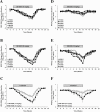Antiviral Efficacy and Host Innate Immunity Associated with SB 9200 Treatment in the Woodchuck Model of Chronic Hepatitis B
- PMID: 27552102
- PMCID: PMC4995001
- DOI: 10.1371/journal.pone.0161313
Antiviral Efficacy and Host Innate Immunity Associated with SB 9200 Treatment in the Woodchuck Model of Chronic Hepatitis B
Abstract
SB 9200, an oral prodrug of the dinucleotide SB 9000, is being developed for the treatment of chronic hepatitis B virus (HBV) infection and represents a novel class of antivirals. SB 9200 is thought to activate the viral sensor proteins, retinoic acid-inducible gene 1 (RIG-I) and nucleotide-binding oligomerization domain-containing protein 2 (NOD2) resulting in interferon (IFN) mediated antiviral immune responses in virus-infected cells. Additionally, the binding of SB 9200 to these sensor proteins could also sterically block the ability of the viral polymerase to access pre-genomic RNA for nucleic acid synthesis. The immune stimulating and direct antiviral properties of SB 9200 were evaluated in woodchucks chronically infected with woodchuck hepatitis virus (WHV) by daily, oral dosing at 15 and 30 mg/kg for 12 weeks. Prolonged treatment resulted in 2.2 and 3.7 log10 reductions in serum WHV DNA and in 0.5 and 1.6 log10 declines in serum WHV surface antigen from pretreatment level with the lower or higher dose of SB 9200, respectively. SB 9200 treatment also resulted in lower hepatic levels of WHV nucleic acids and antigen and reduced liver inflammation. Following treatment cessation, recrudescence of viral replication was observed but with dose-dependent delays in viral relapse. The antiviral effects were associated with dose-dependent and long-lasting induction of IFN-α, IFN-β and IFN-stimulated genes in blood and liver, which correlated with the prolonged activation of the RIG-I/NOD2 pathway and hepatic presence of elevated RIG-I protein levels. These results suggest that in addition to a direct antiviral activity, SB 9200 induces antiviral immunity during chronic hepadnaviral infection via activation of the viral sensor pathway.
Conflict of interest statement
RPI, SP, and AS are employees of Spring Bank Pharmaceuticals, Inc. RKP is a former employee of Spring Bank Pharmaceuticals, Inc. JKM and JS were consultants to Spring Bank Pharmaceuticals, Inc. All other authors, including KEK, SC, MS, JY, BVK, RDT, and SM have declared that no competing interests exist. This does not alter the authors' adherence to PLOS ONE policies on sharing data and materials.
Figures








Similar articles
-
Antiviral Efficacy and Host Immune Response Induction during Sequential Treatment with SB 9200 Followed by Entecavir in Woodchucks.PLoS One. 2017 Jan 5;12(1):e0169631. doi: 10.1371/journal.pone.0169631. eCollection 2017. PLoS One. 2017. PMID: 28056062 Free PMC article.
-
Antiviral effect of oral administration of tenofovir disoproxil fumarate in woodchucks with chronic woodchuck hepatitis virus infection.Antimicrob Agents Chemother. 2005 Jul;49(7):2720-8. doi: 10.1128/AAC.49.7.2720-2728.2005. Antimicrob Agents Chemother. 2005. PMID: 15980342 Free PMC article.
-
Antiviral effects of lamivudine, emtricitabine, adefovir dipivoxil, and tenofovir disoproxil fumarate administered orally alone and in combination to woodchucks with chronic woodchuck hepatitis virus infection.Antimicrob Agents Chemother. 2008 Oct;52(10):3617-32. doi: 10.1128/AAC.00654-08. Epub 2008 Aug 1. Antimicrob Agents Chemother. 2008. PMID: 18676881 Free PMC article.
-
Immunomodulation as an option for the treatment of chronic hepatitis B virus infection: preclinical studies in the woodchuck model.Expert Opin Investig Drugs. 2007 Jun;16(6):787-801. doi: 10.1517/13543784.16.6.787. Expert Opin Investig Drugs. 2007. PMID: 17501692 Review.
-
The woodchuck as an animal model for pathogenesis and therapy of chronic hepatitis B virus infection.World J Gastroenterol. 2007 Jan 7;13(1):104-24. doi: 10.3748/wjg.v13.i1.104. World J Gastroenterol. 2007. PMID: 17206759 Free PMC article. Review.
Cited by
-
Innate immunity and HBV persistence.Curr Opin Virol. 2021 Aug;49:13-20. doi: 10.1016/j.coviro.2021.04.003. Epub 2021 May 13. Curr Opin Virol. 2021. PMID: 33992859 Free PMC article. Review.
-
Ciclopirox inhibits Hepatitis B Virus secretion by blocking capsid assembly.Nat Commun. 2019 May 16;10(1):2184. doi: 10.1038/s41467-019-10200-5. Nat Commun. 2019. PMID: 31097716 Free PMC article.
-
Toll-Like Receptor 7 Agonist RG7854 Mediates Therapeutic Efficacy and Seroconversion in Woodchucks With Chronic Hepatitis B.Front Immunol. 2022 May 23;13:884113. doi: 10.3389/fimmu.2022.884113. eCollection 2022. Front Immunol. 2022. PMID: 35677037 Free PMC article.
-
Strategies to Inhibit Hepatitis B Virus at the Transcript Level.Viruses. 2021 Jul 9;13(7):1327. doi: 10.3390/v13071327. Viruses. 2021. PMID: 34372533 Free PMC article. Review.
-
Innate Immunity, Inflammation, and Intervention in HBV Infection.Viruses. 2022 Oct 17;14(10):2275. doi: 10.3390/v14102275. Viruses. 2022. PMID: 36298831 Free PMC article. Review.
References
-
- Lavanchy D. Hepatitis B virus epidemiology, disease burden, treatment, and current and emerging prevention and control measures. Journal of viral hepatitis. 2004;11(2):97–107. . - PubMed
MeSH terms
Substances
Grants and funding
LinkOut - more resources
Full Text Sources
Other Literature Sources

